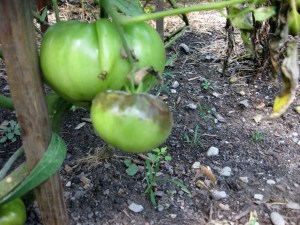Last updated on December 2nd, 2011

What are the dark spots on my tomatoes? Late blight, that’s what. And this fungal phenomenon isn’t “late” this year, but very early…
Dan Barber, in his New York Times op-ed, “You Say Tomato, I Say Agricultural Disaster” (August 8, 2009),discusses late blight, and explains how and why it is rapidly spreading throughout the Northeast. Among other things, he notes the danger of buying starter tomato plants from big box stores like WalMart and Home Depot. You see, such outlets buy their tomatoes from a single grower in the south. Just one plant, if it carries a fungus, soon infects the entire bunch at the big box garden center. And spores from a single diseased plant can quickly spread through entire neighborhoods.
Consequently, it is wise to either start your own plants from seeds, or purchase seedlings from a small, local grower. (You might wish to avoid heirloom varieties, too. They do not possess the disease-resistance of modern types.)
Copper sprays — the traditional method of preventing late blight — have proven largely ineffective in the Northeast this year. Why? Because the fungus thrives in the type of weather we’ve endured throughout the summer of 2009: wet, humid, and cool.
My plan is to harvest — post haste — the remaining blight-free tomatoes in my garden. I’ll use a number of them to make my fabulous Fried Green Tomatoes. Others, after ripening on my kitchen counter, will be frozen or turned into sauce. Then the vines will be destroyed, and in their place will go fast-growing crops of Swiss Chard, beets, beans and lettuce.
Has late blight found its way to your tomatoes, too?
Why miss anything at A Garden for the House? Sign up for my weekly newsletter.
Related Posts:
Fool-Proof Fried Green Tomatoes

Eric says
Kevin, I can sympathize. All of my tomatoes have this fungal condition, too. I'm going to rip out the plants, and replace them with green beans.
Samantha says
Kevin – what varieties did you plant? Are they all effected?
Kevin Lee Jacobs says
Samantha – 'Big Boy' is infected; the Romas are begining to look a little spotty, too. Heirloom varieties (volunteers from last year's crop) seem alright at the moment; they are younger plants, though, and in a separate bed from the others.
Mercifully, my tomatillos are completely free of blight.
Randy J says
Kevin,
I do have the blight on my Yellow Pear tomatoes which are of course an heirloom variety. Thankfully they are planted in containers more than 50' from my vegetable garden. I have not noticed the blight on the Romas or Black Crim plants in my vegetable garden…..yet.
Kevin Lee Jacobs says
Randy – I'll keep my fingers crossed for your Romas and Black Crims!
Alexander says
So THAT'S the gook on with my heirloom Brandywines!
Amy R. says
Hi Kevin! Thank you for all of your articles–they inspired me to plant a second raised bed this summer. Unfortunately, blight has taken hold of my tomato plants. 🙁 do you recommend treating the soil differently this fall/winter in that bed? Would a good tilling and a cover crop help? Should I amend the soil differently? Thank you for this blog and all you do!